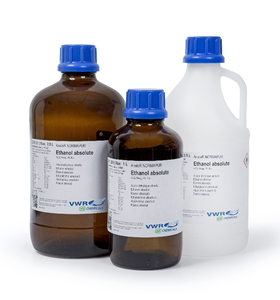VWR® BDH Folin-Ciocalteu'S Reagent For Analysis Of Phenols, 500Ml
Catalog No :
CAS Number :
Brand :
In Stock
Density: 1.22 g/cm³ (20 °C)
Specifications:
| Application | Analytical Chemistry | ||
| Storage Temperature | Ambient | ||
| Product Type | Laboratory Chemical | Forms | Liquid |
| Product Brand | VWR | ||
| Product Grade | Analytical grade | ||
High-Sensitivity Reagent for Total Phenolic Content (TPC) Quantification
VWR® Folin-Ciocalteu’s Reagent is a ready-to-use, high-performance colorimetric reagent specifically designed for the quantitative determination of total phenolic content (TPC) in a wide range of biological, food, pharmaceutical, and environmental samples. Based on a phosphomolybdate–phosphotungstate complex, this reagent reacts with phenolic compounds to produce a blue chromophore measurable at 750–765 nm, allowing for accurate spectrophotometric quantification.
It is widely employed in food science, natural product chemistry, agricultural research, and biomedical studies, offering exceptional reproducibility and sensitivity.
Key Features & Benefits
✅ Sensitive & Specific Detection
- Measures phenolic compounds including flavonoids, tannins, and polyphenols.
- Produces a distinct blue color with peak absorbance at 750–765 nm.
✅ Reliable & Reproducible
- Delivers consistent results with UV-Vis spectrophotometers or microplate readers.
- Suitable for both manual and automated TPC assays.
✅ Versatile Applications
- Ideal for antioxidant quantification in foods, beverages, botanicals, and clinical samples.
- Supports phenolic profiling in agricultural, pharmaceutical, and environmental labs.
✅ Ready-to-Use Format
- Liquid formulation eliminates the need for dilution or reagent preparation.
- Long shelf life under refrigerated conditions.
✅ Laboratory Standard Compliance
- Aligned with standard TPC assay protocols.
- Suitable for research, academic, and industrial quality control settings.
Product Specifications
| Attribute | Details |
|---|---|
| Appearance | Clear to light yellow liquid |
| Chemical Composition | Phosphomolybdate–Phosphotungstate Complex |
| Detection Wavelength | 750–765 nm |
| Form | Liquid, ready-to-use |
| Storage Conditions | 2–8°C, sealed and protected from light |
| pH Stability | Acidic |
| Compliance | For research use only (RUO) |
| Typical Applications | Food science, pharmacognosy, biochemistry, ecology |
Application Areas
- Food & Beverage Testing – Quantifies antioxidant levels in wines, teas, juices, and plant extracts.
- Pharmaceutical Analysis – Assesses bioactive polyphenols in herbal drugs and nutraceuticals.
- Environmental Monitoring – Detects phenolic pollutants in water and soil samples.
- Biomedical & Nutritional Research – Evaluates phenolic intake and antioxidant activity in biological samples.
Assay Summary
- Prepare Standards & Dilutions (e.g., Gallic acid)
- Mix Sample with Reagent and sodium carbonate
- Incubate for 30–60 minutes at room temperature
- Measure absorbance at 750–765 nm
- Calculate TPC from the calibration curve
Storage & Safety
- Store refrigerated at 2–8°C in a sealed container.
- Use PPE when handling (gloves, goggles, lab coat).
- Dispose according to local chemical waste regulations.
VWR® Folin-Ciocalteu’s Reagent is a trusted, research-grade solution for precise and reproducible quantification of total phenolic content. Its high sensitivity, versatility, and ready-to-use format make it a valuable asset in analytical laboratories across food science, pharmaceuticals, biochemistry, and environmental studies. Whether you're performing routine TPC assays or conducting advanced antioxidant research, this reagent delivers the accuracy and consistency required for confident results.




 0
0
